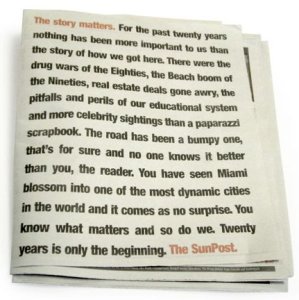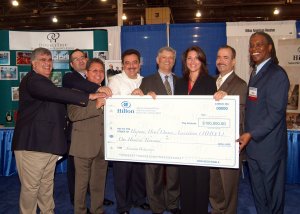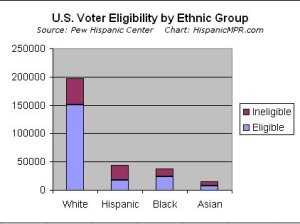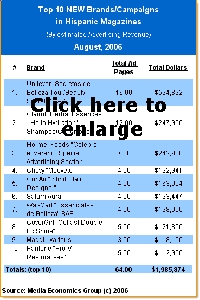Posted by Elena del Valle on November 16, 2006

Eddie Gonzalez, Chairman and CEO, The Bravo Group
Photo: Young & Rubicam and Wunderman
Miami, Florida — The Bravo Group recently was integrated into the existing Young & Rubicam and Wunderman operations in Miami. The merger results in one of the larger agencies in Miami, with over 70 employees.
“With their combined expertise and success in targeting the U.S. Hispanic and Latin American markets, it is a natural fit to join these operations to better serve our clients,” said Eddie Gonzalez, Chairman and CEO of The Bravo Group. “The synergy resulting from this integration allows the combined teams to be more client-focused while operating more efficiently; at the same time we will be in a better position to compete and win business in Miami and nationally.”
Leading Bravo Miami will be Eric Hoyt, president of Young & Rubicam Miami and Wunderman Miami. Hoyt is an industry veteran with over 20 years in the agency and marketing communications fields, including 17 years with Young & Rubicam and Wunderman in Latin America and the U.S.
“Our focus continues to be superior skills and capabilities for an increasingly complex marketplace,” said Mr. Hoyt. “By evolving and expanding our service offering, Bravo Miami and our entire operation are in a better position to provide integrated communications solutions which generate superior business results.”
The Bravo Group, a Young & Rubicam Brands company, is an agency with over 25 years serving multi-national companies trying to reach consumers within the U.S. Hispanic marketplace. Established in 1980, The Bravo Group creates marketing programs that include research and strategic planning, advertising, interactive/digital, direct, promotional and event marketing, media planning/buying, branded entertainment and public relations. The company is headquartered in New York.
Posted by Elena del Valle on November 9, 2006

Turbulence Advertising ad
Photo: Turbulence Advertisting
Miami, Florida – Turbulence Advertising won several Create Awards from Create Magazine, including the Best of Industry in Advertising award for ad copy. The agency was also recognized with Gold awards in the following categories: Advertising Body Copy, Collateral Advertising, Postcard, Self Promotion, Corporate I.D., and Editorial Design Newspaper Cover.
Turbulence received the Self-Promotion recognition for its Corporate ID package and the Editorial Design for Newspaper award for the Manifesto cover design for Miami’s newsweekly, the SunPost. That same entry has also earned the agency awards at the New York Festival, Davey Awards and the Miami Addy’s. Turbulence executives believe the agency’s “open culture” is paramount to its success.
“The Create Awards was launched to showcase the amazing work being done by companies like Turbulence,” said Jerry Brown, publisher and editor of Create Magazine. “Our judges, from multiple creative industries, judged entries based not only on the freshness of the concept/piece, but also its ability to engage the audience. The multiple wins by Turbulence shows that they know how to do that very well.”
Any paid creative work produced for commercial purposes which appeared in the marketplace between January 2005 and June 2006 was eligible for an award. Nineteen judges picked the winners in 10 industries, 40 categories, and 300 subcategories from among 1,500 entries.
“Continuing to be recognized for our work is very satisfying, but even more so when it is acknowledged by industry peers, such as Create Magazine, that truly value the power of great ideas and creativity to solve business challenges,” said Tom Moleta, Turbulence president.
“Ideas happen, but you have to create the right atmosphere and culture to provide smart people the opportunity to generate great ideas,” said Jose Reyes, partner and creative director. “We’re proud that our hard work has paid off, but more importantly, we have fun doing it.”
Founded in January 2005, Turbulence is a “strategic and creative agency, focused and committed to developing breakthrough ideas and solutions to shake things up and move brands to a better place within their business category.” Turbulence’s clients include The Collection, Miami City Ballet, Humana Healthcare, SunPost, Benihana, Doraku Sushi, Ocean Drive magazine, Euphoria Water, Food and Drug Administration and pro bono work for HELP, Inc. and Suited for Success.
First published in 2001, Create Magazine is a quarterly publication that provides creative professionals with an insider’s perspective on the people, news, trends and events that influence the local advertising and creative production industries. With editions in 16 markets nationwide, each issue features articles by local community leaders on the Advertising, Design, Printing, Photography, Film & Video, Animation and New Media industries.
Posted by Elena del Valle on November 7, 2006

Eduardo Perez, president of PM Publicidad
Photo: PM Publicidad
PM Publicidad, an Atlanta full-service Hispanic agency, recently became an affiliate of the San Jose Network (SJN). The three and a half year-old marketing firm is one of 25 agencies in the network of marketing communications firms serving the United States and Latin American markets.
“We now have access to a lot of resources and we have access to a lot of network,” said Eduardo Perez, president of PM Publicidad. “We have the ability to pick up the phone and help people in certain situations or someone who’s part of the network but hasn’t worked for the agency. It gives us additional credibility when we talk to new clients.”
PM Publicidad reaches the Hispanic market through print and broadcast production, event planning and management, media planning, direct marketing, and market research. Its clients include NAPA, Georgia Poison Center, American Society, Arby’s, Georgia Lottery, and others. It has also produced television and radio spots for the Oscars.
“We started from scratch with a lot of people who didn’t have agency experience,” said Perez. “The fact that we succeeded in Atlanta, which wasn’t considered a top Hispanic market at the time we started, is what we’re proud of, succeeding despite challenges.”
Agency executives are also proud of the company’s impact on Atlanta’s fast growing Hispanic community. “We’ve raised the profile of Atlanta. We’re the only full-time Hispanic agency in the city,” said Perez. “This speaks a lot to the importance of Atlanta, where the Hispanics are fast growing and the city has been ranked third in Fortune 500 magazine’s top Hispanic markets. We’ve raised the level of awareness for Atlanta.”
The San Jose Network has affiliate agencies in 25 countries, including the U.S., Mexico, Central America, South America, Puerto Rico and the English-speaking Caribbean. The network started in 1991 as part of the San Jose Group. — Sergio Carmona
Posted by Elena del Valle on November 2, 2006

Happy Birthday Bear card cover
Photo: Lantigua Designs
Weston, Florida – Lantigua Designs, a Florida-based company specializing in Hispanic greeting cards, was chosen to participate in this year’s celebrity gift baskets for the 7th Annual Latin Grammy® Awards. The event, which will take place November 2 in New York City, will be televised on the Univision Network. Some of this year’s Latin Grammys nominees are Shakira, Chayanne, Ricardo Arjona and Fonseca.
“We are very honored to have been chosen for the Latin Grammy celebrity gift baskets,” said Liz Lantigua, creative director and founder of Lantigua Designs, Inc. “This is a great opportunity for all those in the Latin community to know about our products which are so unique and in tune with the Hispanic culture.”
The official talent gift basket will be given to presenters and performers at the Latin Grammy Gift Lounge backstage throughout rehearsals. The famous gift baskets are known to overflow with coveted items ranging from fashion and beauty to electronics and toys. They are chosen and prepared by Distinctive Assets, a company that creates gift baskets for Hollywood events.
Lantigua Designs was created in 2004 to offer Hispanic-themed, Spanish language and bilingual greeting cards that appeal to U.S. Hispanics. The line of cards available is: Birthdays; Dicho Cards based on popular Spanish sayings; All Occasion; Blank Note; Religious; Blank Note Cards such as: Latina and Loving It©, Cubanita That’s Me©, and Kids/Teens greeting cards and party invitations. Lantigua Designs’ cards are available in retail stores in South Florida, New York and Maryland.
Posted by Elena del Valle on October 24, 2006

Alex Garcia, Alberto Delgado, Eloy Salazar, Luis Diaz, Omar Rodriguez, Angela Gonzalez-Rowe, Orr Rivero, and Floyd Pitts at the Hilton HOAA check signing
Photo: Hilton
The Hilton Hotels Corporation became a Founding Corporate Partner of the Hispanic Hotel Owners Association (HHOA). Hilton provided the initial funds required for the association’s formation and preliminary development.
“From its inception, Hilton Hotels Corporation has been supportive of our vision,” said Angela Gonzalez-Rowe, president and founder of HHOA.
The Association was formed as a result of Hilton’s outreach seminar “Hospitality 101.” During the seminar, minority entrepreneurs were trained on the basics of hotel development.
“We are pleased to support HHOA on its mission and believe our involvement speaks volumes on our commitment to Diversity,” said Floyd Pitts, senior director of diversity programs for Hilton Hotel Corporation.
The association is one of the many minority based hotel industry organizations. Others such as the National Black Hotel Owners Operators and Developers (NABHOOD) and the Asian American Hotel Owners Association (AAHOA) have also received support from Hilton.
The non-profit organization is headquartered in Washington, DC. Its mission is to increase the number of Hispanic owned and operated hotels. In addition, HHOA representatives would like to see more executive level employment opportunities within the lodging industry. Hilton Hotels Corporation is a leading global hospitality company, with more than 2,800 hotels in 80 countries. – Melissa Gonzalez
Posted by Elena del Valle on October 18, 2006
By Carlos Pelay
President, Media Economics Group
Top 10 new brands, campaigns in Hispanic magazines
Advertising in Hispanic magazines in August totaled just over $22 million ($22.7m) – a 27.4 percent increase from the previous year. Ad pages were also up by 5.1 percent to 980.81 for the month of August.
Latina and People en Español both posted impressive year-over-year gains in both ad pages and dollars. At People en Español, ad pages were up by 60.1 percent and ad dollars rose by 78 percent. Latina’s ad pages rose by 82.6 percent and ad dollars soared by 89.3 percent.
While People en Español and Latina posted whopping increases in August, the year-to-date comparisons are lower – though still quite good. Through August, ad pages at Latina are up by 7.6 percent and ad dollars are up by 13.4 percent. At People en Español, ad pages are up by 20.1 percent and ad dollars by 32.6 percent.
In August, strong showings by the Personal Care Products ($4,843,177; +49.7 percent), Automotive ($3,748,802; +49.3 percent), and Health Care Products ($1,911,713, +78.6 percent) categories helped to boost overall results.
The strong showing by the Automotive category is especially promising given that weak spending in this category has dampened overall year-to-date ad spending in Hispanic magazines. On a YTD (year to date) basis (Jan-Aug), Automotive spending is still down by 2.7 percent from the previous year.
[A look at our Advance estimates for September suggests that auto spending will likely also post another strong year-over-year increase in September (our Advance estimates are based on a sample of the largest monthly Hispanic magazines). Our Advance estimates show a 14.6 percent increase in Auto spending in September, 2006 compared with previous year.]
Toyota led the Auto spending recovery in August with a year-over-year increase of $383,455 (+122 percent), followed by GM which increased spending in Hispanic magazines by $321,304 (+34 percent). Ford also increased spending significantly by $314,203 (+148 percent).
At the brand level, new campaigns for Volkswagen Jetta ($297,858) and the Toyota Camry SE ($270,674) led the category in spending. Campaigns for new auto brands such as the Jeep Compass ($224,199), Dodge Caliber ($197,473), and the Saturn Aura ($133,447) also helped to boost spending in the Auto category in August.
Besides YTD weakness in the Automotive category, closures of major titles like Shape en Español this year, and Cristina and Nuestra Gente in the latter part of 2005, have also hurt YTD comparisons. Through August, ad dollars are up by 16.5 percent while ad pages are down slightly (-1.6 percent).
August, 2006 Key Stats:
The August, 2006 update includes detailed advertising data for:
- 480 active brands
- 308 active advertisers
- 980.81 total ad pages (+5.1 percent from 2005)
- $22.7 million total ad$ (+27.4 percent from 2005)
Year-to-Date (Jan. – Aug., 2006) Key Stats:
- 1,753 active brands
- 1,016 active advertisers
- 7,368.16 total ad pages (-1.6% from ’05)
- $145.4 million total ad$ (+16.5% from ’05)
New advertising activity for August, 2006 includes 87 New brands/campaigns totaling 167.06 ad pages and $4.2 million in new spending; and 17 new advertisers (parent-company level) totaling 14.47 ad pages and $202,175 in new spending.
Carlos Pelay is founder and president of Media Economics Group, a research firm which provides advertising competitive intelligence services for the multicultural market.
Posted by Elena del Valle on October 17, 2006

William Ortiz, president, GlobalWorks Multicultural Division
Photo: William Ortiz
New York, New York — GlobalWorks Group LLC received four bronze Tellys for TV spots it created for Cablevision Systems Corp.’s digital services. The four 30-second spots target Hispanic and African-American consumers.
“We’re especially gratified to be among the circle of winners, given that our creative was judged in a competition that attracted entries from literally all over the world,” said William Ortiz, president, GlobalWorks Multicultural Division.
The Telly Awards competition attracts more than 12,000 entries annually, from all over the U.S. and many countries. The judges are advertising, production and other creative professionals, who are previous winners of Telly Awards.
“Soccer” was shot by Argentinean director Agustin Alberdi; the three African-American spots were directed by Scotty Bergstein. The spots were conceived and produced by GlobalWorks’ Hispanic and African-American creative teams, under the supervision of Caroline Fish and Takashi Omura, co-creative directors, and Anna Radzievsky, chief creative officer.
GlobalWorks is a New York-based advertising agency that delivers services for managing global brands. In addition to developing award-winning advertising campaigns across media and multicultural markets, GlobalWorks provides technology solutions to help marketers manage their brands worldwide. To view the winning spots, visit GlobalWorks.com
Posted by Elena del Valle on October 12, 2006

U.S. voters by ethnic group
Chart: HispanicMPR.com
According to the latest Pew Hispanic Center updates, 17.2 million Hispanics or 8.6 percent of voters, will be eligible to vote in 2006. That represents an increase of 7 percent over the 2004 election when there were 16 million Hispanic voters representing 8.2 percent of eligible voters in the country.
Native born Hispanics represent 75 percent of Latino voters while foreign born naturalized Hispanics represent 25 percent. Second generation Latino voters exhibited the largest percentage growth, 46 percent, among Hispanic voters since 2004. At the same time Latino voters represent a smaller share of the overall Hispanic population than similar voting segments in other ethnic groups because so many Latinos are underage or adult noncitizens.
According to the Pew Hispanic Center only 39 percent of Latinos may vote while 77 percent of nonHispanic whites and 65 percent of nonHispanic blacks are eligible to vote. In other words, of 200 million eligible voters, 150.8 are nonHispanic white, 24.1 million are nonHispanic black, 17 million are Latino and 7.4 million are nonHispanic Asian. The Center estimates that between 10 million and 12.3 million Latinos will register to vote by November 2006.
Posted by Elena del Valle on October 10, 2006


Scenes from the public service announcement
Photos: Creative Marketing Partners
Miami, Florida – The statistics are staggering: Motor vehicle accidents are the leading cause of death in the United States for Hispanics between 34 and under according to the National Highway Traffic Safety Administration (NHTSA). Organizers of a South Florida campaign to prevent drinking and driving, indicate that thirty percent of Americans will be involved in an alcohol-related crash in their lifetimes. Such accidents cause damages worth more than $50 billion a year according to a 2002 NHTSA study about the economic impact of crashes.
To counter this trend, a Miami car dealer, Esserman Nissan, donated $20,000 in production costs to develop a bilingual 30-second television public service announcement. The dealer’s advertising agency, Creative Marketing Partners (CMP), developed the campaign probono. The announcements began airing in South Florida stations the first week of October and will continue for a total of 12 weeks.
The spots have been airing in two Spanish language and three English language stations in Miami-Dade and Broward counties: WFOR (CBS), WTVJ (NBC), WSVN (Fox) in English and WLTV (Univision), WSCV (Telemundo) in Spanish.
After a decline of alcohol-impaired driving throughout most of the 1990s, a new study published in the May 2005 issue of the American Journal of Preventive Medicine, shows that driving while intoxicated has increased significantly and researchers believe it is linked to an increase in binge drinking.
National Highway Traffic Safety Administration (NHTSA) 2005 statistics indicate that alcohol-related deaths account for half of all Hispanic traffic-related fatalities. The Administration considers impaired driving a public health epidemic and places Hispanics at high risk.
In the spots, conceived and produced by CMP, two young men let the air out of the tire of a sporty Nissan parked outside a trendy nightclub. Minutes later, an obviously drunk driver stumbles to his car and realizes he cannot go anywhere because of the flat tire. The spot ends with the announcer saying: “Good friends will do anything to keep you from drinking and driving.”
The reaction from viewers has been extremely favorable, said Dick Assmar, vice-president of Esserman Nissan. “We did this because we are concerned by the fact that drunken driving statistics are on the rise. We are very pleased by the acceptance on the part of the media and the TV viewers.”
Esserman Nissan is a South Florida automobile dealer and the only recipient of Nissan’s Owner First Award of Excellence 5 years in a row. Creative Marketing Partners is a South Florida advertising agency that specializes in providing advertising and marketing services for automobile dealers, dealer advertising groups, and automobile manufacturers, as well as the real estate and health-care industries. To view the spots online visit: English version and Spanish version
Posted by Elena del Valle on October 6, 2006


GoldLeaf Jewelry tiara and pendant for quinceañeras
Photos: GoldLeaf Jewelry
A Quinceañera, the Hispanic equivalent of a Sweet Sixteen celebration, can be the most memorable day in a young woman’s life. The preparations for it however, can be as stressful as a wedding. They can affect mothers reliving their childhood, fathers worried about losing their little girls and teenagers expected to be perfect and beautiful on their special day.
GoldLeaf Jewelry is attempting to take some of the stress away by offering for sale traditional tiaras, rosaries, and charms to help young Latinas celebrate their 15 birthday. The jeweler, one of several offering Quinceañera jewelry, specializes in 14K gold, with prices ranging from $100 to $700. The company works with more than 100 manufacturers from four continents to obtain quality materials.

Renada Dukalskis
“Throughout my research it became clear to me that not only could GoldLeaf meet a market need as a place where girls could go online for beautiful, traditional, high-end Quinceañera jewelry but that we could also become a leader in a segment where there isn’t one,” said Renada Dukalsis of GoldLeaf Jewelry.
Robert and Renada Dukalskis, a father-daughter team from Oregon, founded an online store specializing in jewelry for coming of age celebrations. Robert, who has many years of retail experience, focuses on the logistics of the company. Renada handles the marketing. After years of marketing experience she is centering her attention on the growing family business. The company will donate a portion of sales to the MS Foundation for Women, a non-profit organization focusing on women’s issues. — Melissa Gonzalez






















